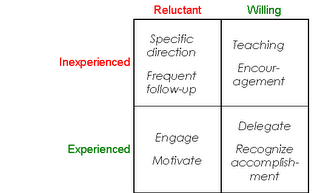Situational Leadership in a Nutshell
A big part of managing effectively is knowing how deeply to become involved in guiding the work of employees to whom you have delegated specific tasks. The key is to adapt your approach to each individual and task — hence the label "situational leadership" that has been given to this approach to getting results through others.When delegating a task or responsibility, consider both the employee's current skills (ability to perform well) and the employee's motivation (willingness to perform well). As shown in the graphic below, there are four possibilities, based on whether the employee is inexperienced or experienced with the particular task, and on whether the employee is reluctant or willing to tackle the task.

For example, with an inexperienced employee who is leary of the task you are delegating, you need to provide specific direction and frequent follow-up. By contrast, with an employee who is both experienced and willing, your role is to go ahead and delegate the task, and, assuming no unusual snags, to then recognize the employee's accomplishment when the task is completed.
Note that if the employee's performance is not up to standard, you need to identify the root cause of the deficiency. Besides lack of skill and/or willingness, other possibilities are:
- The employee isn't aware that there's a problem.
- The employee isn't clear about the expected results.
- There is an organizational barrier to getting the task done.
- The task is a poor fit for the particular employee. (E.g., the employee might be both experienced and willing, but be better suited by personal style to other types of work.)
Labels: Leadership, Management practices
<< Home